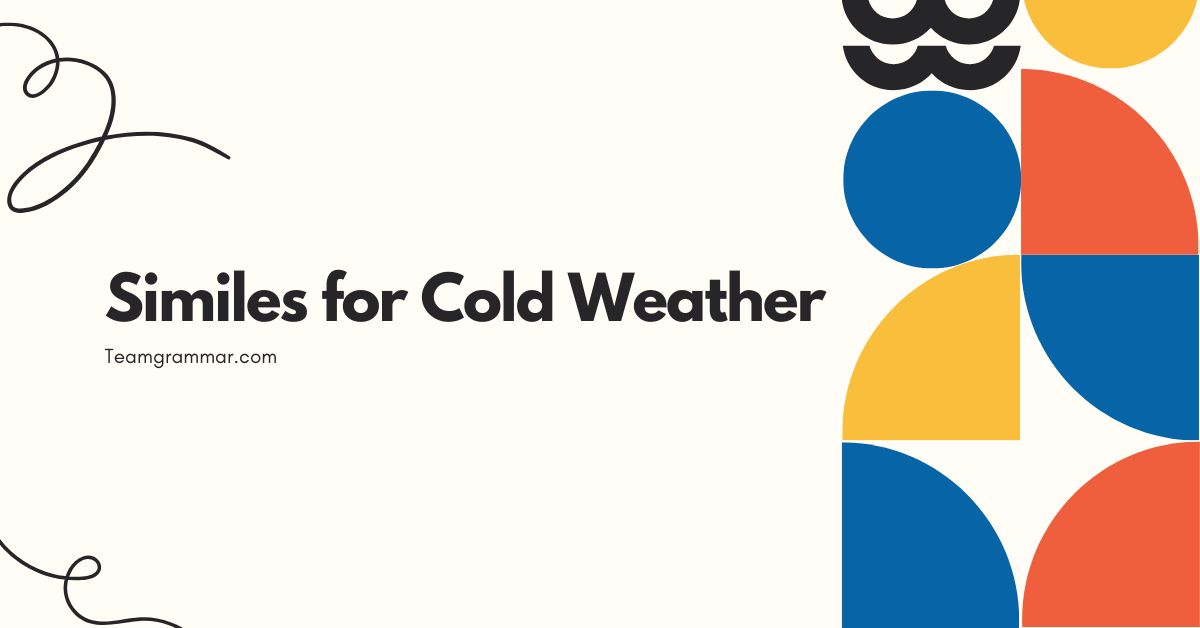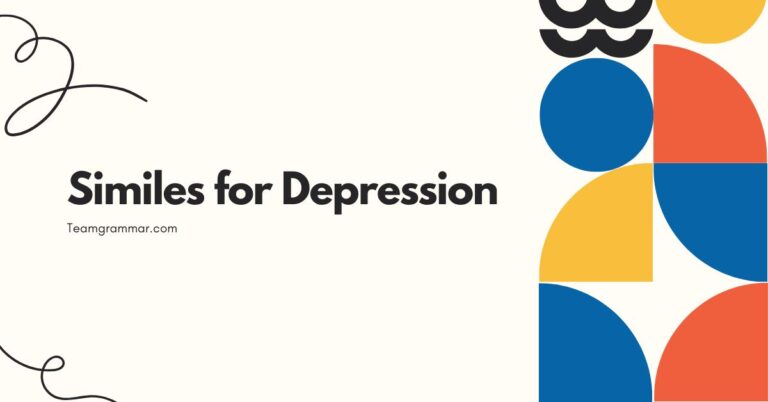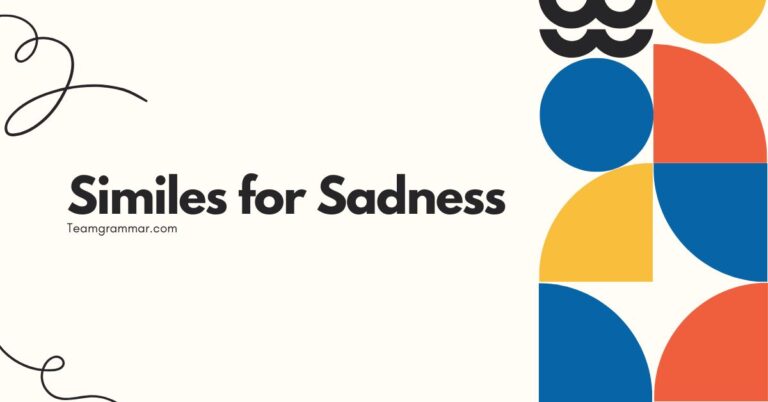40 Similes for Cold Weather: A Comprehensive Guide
Understanding similes is crucial for enhancing descriptive writing and adding depth to your language. Similes, which compare two unlike things using “like” or “as,” are particularly effective in conveying sensory experiences, such as the feeling of cold weather.
This article provides a comprehensive guide to using similes to describe cold weather, exploring their structure, various types, and practical applications. Whether you’re a student, writer, or language enthusiast, this guide will equip you with the knowledge and skills to use similes effectively in your writing and speech.
This resource is designed for English language learners, writers seeking to enrich their descriptive vocabulary, and anyone interested in the nuances of figurative language. By mastering the art of crafting and understanding similes, you can elevate your communication skills and paint vivid pictures with your words.
Table of Contents
- Definition of Similes
- Structural Breakdown of Similes
- Types or Categories of Similes for Cold Weather
- Examples of Similes for Cold Weather
- Usage Rules for Similes
- Common Mistakes When Using Similes
- Practice Exercises
- Advanced Topics in Similes
- Frequently Asked Questions (FAQ)
- Conclusion
Definition of Similes
A simile is a figure of speech that compares two unlike things using the words “like” or “as.” The purpose of a simile is to create a vivid image or enhance understanding by drawing a parallel between two distinct concepts. In the context of cold weather, similes can be used to describe the intensity of the cold, the physical sensations it evokes, and the overall atmosphere it creates.
Similes are a type of figurative language, which means they use words or expressions with a meaning that is different from the literal interpretation. This allows for more creative and impactful communication.
For instance, instead of simply saying “it’s very cold,” you could say “it’s as cold as ice,” which provides a more sensory and descriptive experience for the reader or listener.
The function of a simile is to make a comparison that illuminates a particular quality or characteristic. In the case of cold weather similes, the goal is to highlight the severity, sharpness, or other aspects of the cold.
These comparisons can range from the commonplace, such as “cold as ice,” to more imaginative and original expressions.
Classification of Similes
Similes can be classified based on the type of comparison they make. For example, some similes focus on the intensity of the cold, while others describe the physical sensations it causes.
Understanding these classifications can help you choose the most appropriate simile for your specific descriptive needs.
Function of Similes
The primary function of similes is to enhance descriptions by making comparisons that are easily understood and relatable. They create a more vivid and memorable image in the reader’s mind.
In the context of cold weather, similes can convey the biting wind, the frozen ground, or the overall feeling of being chilled to the bone.
Contexts for Using Similes
Similes are appropriate in a wide range of contexts, including creative writing, descriptive essays, poetry, and even everyday conversation. They are particularly useful when you want to evoke a strong emotional response or create a specific atmosphere.
When describing cold weather, similes can help readers or listeners feel as though they are experiencing the cold firsthand.
Structural Breakdown of Similes
A simile typically consists of three main components: the subject being described, the word “like” or “as,” and the object or concept to which it is being compared. Understanding the structural elements can help you create effective and grammatically correct similes.
The basic pattern of a simile is: Subject + “like” or “as” + Object of Comparison. For example, in the simile “The wind was like a razor,” “the wind” is the subject, “like” is the comparison word, and “a razor” is the object of comparison.
This structure is consistent across all types of similes.
Subject: This is the noun or noun phrase that is being described. In cold weather similes, the subject might be the wind, the air, the snow, or even a person’s body.
Comparison Word: This is either “like” or “as.” These words signal that a comparison is being made. While both are generally interchangeable, “as” is often used in more formal writing, while “like” is more common in informal contexts.
Object of Comparison:This is the noun or noun phrase to which the subject is being compared. It should be something that is commonly associated with the quality being described.
For example, ice, stone, or a freezer are common objects of comparison when describing cold weather.
Common Patterns in Similes
There are several common patterns used in similes, each with its own nuances. One common pattern is using adjectives to describe both the subject and the object of comparison.
For example, “The air was as crisp as a freshly picked apple.” Another pattern is using verbs to describe the action or effect of the cold, such as “The wind bit like a hungry wolf.”
Grammatical Rules for Similes
When constructing similes, it’s important to ensure that the comparison is logical and the grammar is correct. The subject and object of comparison should be comparable in some way, and the simile should make sense in the context in which it is used.
Additionally, the tense and number of the subject and object of comparison should agree.
Types or Categories of Similes for Cold Weather
Similes for cold weather can be categorized based on the aspect of cold they emphasize. These categories include intensity, sensation, appearance, and effect.
Each category provides a different way to describe the cold and can be used to create a more nuanced and descriptive picture.
Similes Describing Intensity
These similes focus on how strong or severe the cold is. They often use comparisons to things that are known for their extreme coldness, such as ice, glaciers, or the arctic.
Similes Describing Sensation
These similes describe the physical sensations caused by the cold, such as shivering, numbness, or a biting feeling. They often use comparisons to sharp or painful objects or experiences.
Similes Describing Appearance
These similes describe how the cold weather looks, such as the appearance of frost, snow, or ice. They often use comparisons to white or crystalline objects or textures.
Similes Describing Effect
These similes describe the effect of the cold weather on people, animals, or the environment. They often use comparisons to things that are frozen, immobile, or lifeless.
Examples of Similes for Cold Weather
Here are some examples of similes for cold weather, organized by category. Each example is designed to illustrate how similes can be used to create vivid and descriptive language.
The following tables provide extensive examples of similes describing cold weather, categorized by intensity, sensation, appearance, and effect. These examples aim to illustrate the diverse ways in which similes can be used to enhance descriptive writing.
Intensity Similes
These similes emphasize the extreme severity of the cold. They often compare the cold to things known for their intense coldness, such as ice, glaciers, or the Arctic.
Below is a table of similes describing the intensity of cold weather:
| Simile | Explanation |
|---|---|
| As cold as ice | A classic comparison, emphasizing the freezing temperature. |
| As cold as a glacier | Highlights the immense, frozen nature of a glacier. |
| As cold as the Arctic | Refers to the extreme cold of the Arctic region. |
| As cold as a freezer | Relates the cold to a common household appliance known for freezing. |
| As cold as a witch’s heart | A more figurative comparison, suggesting a heartless, icy cold. |
| As cold as space | Emphasizes the absolute zero temperature of outer space. |
| As cold as a morgue | Compares the temperature to that of a place where bodies are kept. |
| As cold as liquid nitrogen | Highlights the extremely low temperature of liquid nitrogen. |
| As cold as a well digger’s feet | A regional simile referring to prolonged exposure to cold water. |
| As cold as charity | A figurative comparison suggesting a lack of warmth or generosity. |
| As cold as a banker’s smile | Suggests a superficial, unfeeling demeanor. |
| As cold as a tomb | Evokes the chilling atmosphere of a burial place. |
| As cold as steel | Highlights the unyielding, frigid nature of metal. |
| As cold as granite | Emphasizes the solid, unfeeling cold of stone. |
| As cold as death | A stark comparison to the ultimate state of coldness. |
| As cold as a polar bear’s nose | Highlights the adaptation to extreme cold. |
| As cold as a penguin’s flipper | Another comparison to animals adapted to icy conditions. |
| As cold as ice water | A simple, direct comparison to freezing water. |
| As cold as a refrigerator | A common household comparison. |
| As cold as a snowman’s heart | A whimsical, figurative comparison. |
| As cold as the North Pole | A geographical reference to extreme cold. |
| As cold as a January morning | A seasonal reference to the coldest month. |
| As cold as a frozen lake | Emphasizes the solid, icy surface. |
| As cold as a shaded forest floor | Highlights the lack of sunlight and warmth. |
| As cold as a grave | Similar to “as cold as a tomb,” evoking a chilling atmosphere. |
Sensation Similes
These similes focus on the physical sensations caused by the cold, such as shivering, numbness, or a biting feeling. They often draw comparisons to sharp or painful objects or experiences.
Below is a table of similes describing the sensation of cold weather:
| Simile | Explanation |
|---|---|
| Biting like a thousand needles | Describes the sharp, stinging sensation of extreme cold. |
| Stinging like frostbite | Compares the feeling to the pain of frostbite. |
| Numbing like Novocain | Refers to the sensation of numbness caused by cold. |
| Piercing like an icicle | Highlights the sharp, penetrating feeling of cold. |
| Like knives cutting through skin | Emphasizes the painful, sharp sensation of cold wind. |
| As sharp as shattered glass | Conveys the biting, cutting feeling of cold air. |
| Like walking through frozen molasses | Describes the heavy, slow feeling caused by extreme cold. |
| As if tiny hammers were tapping | Describes the sensation of shivering or chattering teeth. |
| Like a thousand icy ants crawling | Highlights the tingling, uncomfortable feeling of cold. |
| As if your bones were turning to ice | Emphasizes the deep, penetrating cold feeling. |
| Like being wrapped in a frozen shroud | Conveys a sense of being completely enveloped by cold. |
| As if your breath could shatter | Highlights the extreme cold that freezes breath in the air. |
| Like a cold fist clenching your heart | A figurative comparison suggesting a painful, constricting sensation. |
| As if your blood were turning to slush | Emphasizes the slow, sluggish feeling caused by cold. |
| Like pins and needles on your skin | Describes the tingling, prickling sensation of cold. |
| As if the air itself were frozen solid | Highlights the dense, unyielding sensation of cold air. |
| Like a cold wave crashing over you | Conveys the sudden, overwhelming feeling of cold. |
| As if your lungs were filled with ice | Emphasizes the difficulty breathing in extreme cold. |
| Like a cold blade against your cheek | Highlights the sharp, cutting sensation of cold wind. |
| As if your eyes were freezing open | Emphasizes the stinging, watering sensation of cold. |
| Like a frozen spider crawling on skin | Conveys the unsettling, chilling sensation of cold. |
| As if your teeth were made of ice | Highlights the chattering, freezing sensation of teeth. |
| Like a cold sponge absorbing warmth | Describes the way cold weather saps body heat. |
| As if your fingers were turning to stone | Emphasizes the numbness and immobility caused by cold. |
| Like a cold hand gripping your throat | A figurative comparison suggesting difficulty breathing. |
Appearance Similes
These similes describe how the cold weather looks, focusing on the appearance of frost, snow, or ice. They often use comparisons to white or crystalline objects or textures.
Below is a table of similes describing the appearance of cold weather:
| Simile | Explanation |
|---|---|
| As white as a sheet | Describes the pure white color of snow or frost. |
| Sparkling like diamonds | Highlights the glittering appearance of ice crystals. |
| As clear as crystal | Describes the transparency and purity of ice. |
| Glistening like a frozen waterfall | Emphasizes the shimmering, icy appearance of a frozen waterfall. |
| Like a world covered in powdered sugar | Describes the soft, white blanket of snow. |
| As pristine as untouched snow | Highlights the purity and untouched beauty of fresh snow. |
| Like a landscape of frozen dreams | A figurative comparison suggesting a surreal, icy scene. |
| As if the trees were wearing icy armor | Describes the appearance of trees covered in ice. |
| Like a canvas painted in shades of white | Emphasizes the monochromatic beauty of a snowy landscape. |
| As delicate as a snowflake | Highlights the intricate, fragile beauty of snowflakes. |
| Like a frozen ocean of white | Describes a vast, snowy expanse. |
| As if the world were dipped in ice | Emphasizes the complete icy transformation of the landscape. |
| Like a city sculpted from ice | A figurative comparison suggesting an icy, architectural scene. |
| As shimmering as a frozen lake | Highlights the reflective, icy surface of a frozen lake. |
| Like a winter wonderland postcard | Describes a picturesque, idyllic snowy scene. |
| As if the clouds were made of ice | Emphasizes the cold, icy appearance of the sky. |
| Like a frozen tapestry | Describes the intricate patterns of ice and snow. |
| As dazzling as a snow queen’s gown | A figurative comparison suggesting a beautiful, icy garment. |
| Like a frozen curtain of icicles | Describes the hanging, icy appearance of icicles. |
| As transparent as a frozen tear | Highlights the clear, pure appearance of ice. |
| Like a frozen river of light | Describes the shimmering, reflective surface of a frozen river. |
| As if the sun were made of ice | Emphasizes the cold, distant appearance of the sun in winter. |
| Like a frozen garden of glass | A figurative comparison suggesting a delicate, icy scene. |
| As smooth as a frozen mirror | Highlights the reflective, icy surface of a frozen body of water. |
| Like a frozen sculpture in time | Describes the timeless, icy beauty of a frozen landscape. |
Effect Similes
These similes describe the effect of the cold weather on people, animals, or the environment. They often use comparisons to things that are frozen, immobile, or lifeless.
Below is a table of similes describing the effects of cold weather:
| Simile | Explanation |
|---|---|
| Frozen like a statue | Describes the immobility caused by extreme cold. |
| As still as a frozen pond | Highlights the stillness and lack of movement caused by cold. |
| Like a world in suspended animation | Describes the way cold weather can bring life to a standstill. |
| As if time itself were frozen | Emphasizes the slow, stagnant feeling of cold weather. |
| Like a city under a spell of ice | A figurative comparison suggesting a city transformed by cold. |
| As silent as a frozen forest | Highlights the lack of sound caused by cold weather. |
| Like a landscape preserved in ice | Describes the way cold weather can preserve things. |
| As if the trees were holding their breath | A figurative comparison suggesting the stillness of trees in winter. |
| Like a world waiting for spring | Emphasizes the anticipation of warmer weather. |
| As barren as a frozen tundra | Highlights the lack of life in a cold, desolate landscape. |
| Like a frozen photograph | Describes the way cold weather can capture a moment in time. |
| As if the sun had forgotten to shine | Emphasizes the lack of warmth and light in winter. |
| Like a world silenced by ice | Highlights the lack of noise caused by cold weather. |
| As if the animals were hibernating in time | Describes the way animals disappear during winter. |
| Like a frozen stage set for a play | A figurative comparison suggesting a theatrical, icy scene. |
| As if the birds had flown to warmer dreams | Emphasizes the absence of birds during winter. |
| Like a world wrapped in a frozen embrace | Describes the all-encompassing nature of cold weather. |
| As if the rivers had forgotten to flow | Emphasizes the stillness of frozen rivers. |
| Like a frozen symphony of silence | A figurative comparison suggesting a quiet, icy scene. |
| As if the flowers were dreaming of spring | Emphasizes the anticipation of warmer weather. |
| Like a world paused by winter’s hand | Describes the way winter can bring life to a standstill. |
| As if the seasons were holding their breath | Emphasizes the anticipation of the changing seasons. |
| Like a frozen painting on nature’s wall | A figurative comparison suggesting a beautiful, icy scene. |
| As if the world were sleeping under ice | Describes the way winter can bring a sense of dormancy. |
| Like a frozen echo of summer’s warmth | Emphasizes the memory of warmer weather. |
Usage Rules for Similes
Using similes effectively requires an understanding of the rules that govern their proper use. These rules ensure that similes are clear, logical, and grammatically correct.
Clarity: A good simile should be easy to understand. The comparison should be clear and the object of comparison should be something that is familiar to the reader or listener.
Logic: The comparison should be logical and make sense in the context in which it is used. The subject and object of comparison should share some common quality or characteristic.
Originality: While common similes can be effective, original similes can add a unique and creative touch to your writing. Try to come up with comparisons that are fresh and unexpected.
Grammar: Ensure that the simile is grammatically correct. The tense and number of the subject and object of comparison should agree.
Exceptions to the Rules
While the above rules are generally applicable, there are some exceptions. For example, in creative writing, it is sometimes acceptable to use similes that are slightly illogical or unconventional, as long as they are effective in conveying a particular mood or emotion.
Special Cases
In some cases, similes can be combined with other figures of speech, such as metaphors or personification, to create even more descriptive and impactful language. However, it’s important to use these techniques judiciously to avoid confusing the reader or listener.
Common Mistakes When Using Similes
Even experienced writers can make mistakes when using similes. Here are some common errors to avoid:
Clichés: Avoid using overused or clichéd similes, such as “as cold as ice” or “as white as snow.” These similes have lost their impact and can make your writing seem unoriginal.
Illogical Comparisons: Ensure that the comparison is logical and makes sense. Avoid comparing things that have no common qualities or characteristics.
Grammatical Errors: Pay attention to grammar and ensure that the simile is grammatically correct. Avoid errors in tense, number, or word choice.
Overuse: While similes can be effective, avoid using too many of them in a single piece of writing. Overuse can make your writing seem cluttered and distracting.
Here are some examples of common mistakes with similes, along with corrections:
| Incorrect | Correct | Explanation |
|---|---|---|
| The wind was cold like potato. | The wind was cold like an ice storm. | Potatoes are not typically associated with cold weather. |
| It was as cold as a hot fire. | It was as cold as a frozen lake. | A hot fire is the opposite of cold. |
| The snow was as white as black. | The snow was as white as a dove. | Black is the opposite of white. |
| He shivered like happy. | He shivered like a leaf in the wind. | “Happy” is an emotion, not a physical comparison. |
Practice Exercises
Test your understanding of similes with these practice exercises. For each question, choose the best simile to complete the sentence.
Complete the following sentences with an appropriate simile:
| Question | Answer |
|---|---|
| 1. The wind was ________, cutting through our coats. | as sharp as a razor |
| 2. The snow fell ________, covering the town in a blanket of white. | as softly as feathers |
| 3. The air was ________, making it hard to breathe. | as cold as ice |
| 4. The lake was ________, reflecting the gray sky above. | as still as glass |
| 5. My fingers were ________, despite my gloves. | as numb as stone |
| 6. The trees stood ________, their branches heavy with snow. | as silent as statues |
| 7. The cold seeped into our bones ________. | like a chilling ghost |
| 8. The frost sparkled on the grass ________. | like a million tiny diamonds |
| 9. The winter sky was ________, promising more snow. | as gray as lead |
| 10. The icy wind howled ________ through the empty streets. | like a banshee’s wail |
Rewrite the following sentences using similes to describe the cold weather:
| Original Sentence | Sentence with Simile |
|---|---|
| 1. The weather was very cold. | The weather was as cold as a polar bear’s embrace. |
| 2. The wind was strong and freezing. | The wind was like a frozen whip, lashing against our faces. |
| 3. The snow was falling heavily. | The snow fell like a curtain of white, obscuring the world. |
| 4. The ice was very slippery. | The ice was as slippery as a greased slide. |
| 5. The air was still and frigid. | The air was as still and frigid as a tomb. |
| 6. My hands were numb from the cold. | My hands were as numb as if they were filled with ice. |
| 7. The landscape was covered in white. | The landscape was as white as a freshly laundered sheet. |
| 8. The silence was profound. | The silence was like a thick, frozen blanket, muffling all sound. |
| 9. The cold was penetrating. | The cold was penetrating like a dagger to the heart. |
| 10. The day was bleak and icy. | The day was as bleak and icy as a winter’s grave. |
Advanced Topics in Similes
For advanced learners, there are several more complex aspects of similes to explore. These include the use of extended similes, the combination of similes with other figures of speech, and the cultural variations in simile usage.
Extended Similes: An extended simile is a simile that is developed over several lines or paragraphs. This allows for a more detailed and nuanced comparison.
Combining Similes: Similes can be combined with other figures of speech, such as metaphors, personification, or hyperbole, to create even more descriptive and impactful language.
Cultural Variations: The specific objects of comparison used in similes can vary across cultures. Understanding these cultural variations can help you use similes more effectively in cross-cultural communication.
Frequently Asked Questions (FAQ)
Here are some frequently asked questions about similes:
- What is the difference between a simile and a metaphor?
A simile compares two things using “like” or “as,” while a metaphor directly equates two things without using these words. For example, “The wind was like a razor” (simile) versus “The wind was a razor” (metaphor).
- Can a simile be too obvious or cliché?
Yes, overused similes like “as cold as ice” can lack impact. Strive for originality to make your writing more engaging and descriptive.
- How can I make my similes more creative?
Think outside the box and consider unexpected comparisons. Use sensory details and vivid imagery to create a stronger impact.
- Is it okay to use similes in formal writing?
Yes, but use them sparingly. Overuse can make your writing seem less serious. Choose similes that enhance clarity and add depth without being distracting.
- What are some common mistakes to avoid when using similes?
Avoid clichés, illogical comparisons, and grammatical errors. Ensure your similes are clear, logical, and grammatically correct.
- How do I identify a simile in a sentence?
Look for the words “like” or “as.” If a sentence compares two unlike things using these words, it’s likely a simile.
- Can a simile be more than one sentence long?
Yes, an extended simile can be developed over multiple sentences or even a paragraph to create a more detailed and nuanced comparison.
- Are similes only used in writing, or can they be used in speech as well?
Similes are used in both writing and speech. They are a versatile tool for enhancing communication in various contexts.
- How important is it to use correct grammar when constructing a simile?
Correct grammar is crucial for ensuring that your simile is clear and effective. Pay attention to tense, number, and word choice to avoid confusion.
- Can the use of similes vary across different cultures or languages?
Yes, the specific objects of comparison used in similes can vary across cultures. Being aware of these variations can help you communicate more effectively in diverse settings.
Conclusion
Mastering the art of using similes can significantly enhance your descriptive writing and communication skills. By understanding the structure, types, and usage rules of similes, you can craft vivid and impactful comparisons that bring your words to life.
When describing cold weather, similes can help you convey the intensity, sensation, appearance, and effect of the cold in a way that is both memorable and engaging.
Remember to avoid clichés, illogical comparisons, and grammatical errors. Strive for originality and use similes judiciously to enhance your writing without overwhelming it.
With practice and attention to detail, you can become proficient in using similes to create compelling and descriptive language. Continue to explore and experiment with different similes to find your unique voice and style.







